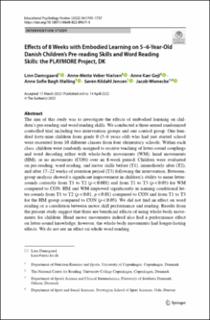| dc.contributor.author | Damsgaard, Linn | |
| dc.contributor.author | Nielsen, Anne-Mette Veber | |
| dc.contributor.author | Gejl, Anne Kær | |
| dc.contributor.author | Malling, Anne Sofie Bøgh | |
| dc.contributor.author | Jensen, Søren Kildahl | |
| dc.contributor.author | Wienecke, Jacob | |
| dc.date.accessioned | 2022-09-01T12:17:55Z | |
| dc.date.available | 2022-09-01T12:17:55Z | |
| dc.date.created | 2022-05-23T13:06:00Z | |
| dc.date.issued | 2022 | |
| dc.identifier.citation | Educational Psychology Review. 2022, 34(3), Side 1709-1737. | en_US |
| dc.identifier.issn | 1040-726X | |
| dc.identifier.uri | https://hdl.handle.net/11250/3015161 | |
| dc.description | This article is licensed under a Creative Commons Attribution 4.0 International License, which permits use, sharing, adaptation, distribution and reproduction in any medium or format, as long as you give appropriate credit to the original author(s) and the source, provide a link to the Creative Commons license, and indicate if changes were made. The images or other third party material in this article are included in the article's Creative Commons license, unless indicated otherwise in a credit line to the material. If material is not included in the article's Creative Commons license and your intended use is not permitted by statutory regulation or exceeds the permitted use, you will need to obtain permission directly from the copyright holder. | en_US |
| dc.description.abstract | The aim of this study was to investigate the effects of embodied learning on children’s pre-reading and word reading skills. We conducted a three-armed randomized controlled trial including two intervention groups and one control group. One hundred forty-nine children from grade 0 (5–6 years old) who had just started school were recruited from 10 different classes from four elementary schools. Within each class, children were randomly assigned to receive teaching of letter-sound couplings and word decoding either with whole-body movements (WM), hand movements (HM), or no movements (CON) over an 8-week period. Children were evaluated on pre-reading, word reading, and motor skills before (T1), immediately after (T2), and after 17–22 weeks of retention period (T3) following the intervention. Between-group analysis showed a significant improvement in children’s ability to name letter-sounds correctly from T1 to T2 (p < 0.001) and from T1 to T3 (p < 0.05) for WM compared to CON. HM and WM improved significantly in naming conditional letter-sounds from T1 to T2 (p < 0.01, p < 0.01) compared to CON and from T1 to T3 for the HM group compared to CON (p < 0.05). We did not find an effect on word reading or a correlation between motor skill performance and reading. Results from the present study suggest that there are beneficial effects of using whole-body movements for children. Hand motor movements indeed also had a performance effect on letter-sound knowledge; however, the whole-body movements had longer-lasting effects. We do not see an effect on whole word reading. | en_US |
| dc.language.iso | eng | en_US |
| dc.subject | children | en_US |
| dc.subject | Denmark | en_US |
| dc.subject | embodied learning | en_US |
| dc.subject | motor skills | en_US |
| dc.subject | PLAYMORE | en_US |
| dc.subject | reading | en_US |
| dc.title | Effects of 8 weeks with embodied learning on 5–6-year-old Danish children’s pre-reading skills and word reading skills: The PLAYMORE project, DK | en_US |
| dc.type | Peer reviewed | en_US |
| dc.type | Journal article | en_US |
| dc.description.version | publishedVersion | en_US |
| dc.rights.holder | © 2022 The Author(s) | en_US |
| dc.source.pagenumber | 1709-1737 | en_US |
| dc.source.volume | 34 | en_US |
| dc.source.journal | Educational Psychology Review | en_US |
| dc.source.issue | 3 | en_US |
| dc.identifier.doi | 10.1007/s10648-022-09671-8 | |
| dc.identifier.cristin | 2026523 | |
| dc.description.localcode | Institutt for idrett og samfunnsvitenskap / Department of Sport and Social Sciences | en_US |
| cristin.ispublished | true | |
| cristin.fulltext | original | |
| cristin.qualitycode | 1 | |
